But Report Says They Never Reported Concerns
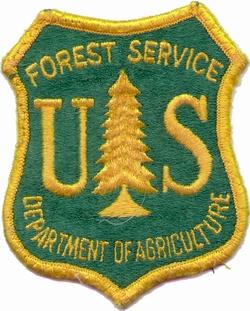 You know the drill. You worry about your 30-year
old aircraft, but, after all, it's been flying so well for so long,
you talk yourself out of your concerns. Besides, there's work to
do. You know how the drill sometimes end, too. Eventually, one of
those worries can kill you.
You know the drill. You worry about your 30-year
old aircraft, but, after all, it's been flying so well for so long,
you talk yourself out of your concerns. Besides, there's work to
do. You know how the drill sometimes end, too. Eventually, one of
those worries can kill you.
Steven Wass Was Worried
Firefighting tanker pilot Steven Wass repeatedly told
colleagues, friends and family about his worries concerning the
structural integrity of aging C-130A firefighting aircraft. He was
especially concerned about the wings. That's the finding of a new
831-page Forest Service accident report.
Wass, 42, of Gardnerville (NV), always kept on board with him a
copy of an accident report on a triple fatal accident involving a
C-130A just like the one he was flying, a plane that had rolled off
the Lockheed production line in 1957 just two serial numbers after
his.
That plane crashed in Southern California in 1994 after the
wings fell off, just as his did years later. "Steve Wass was very
aware of the weak structure of the C-130s," according to one of
more than 40 witnesses interviewed by Forest Service special agents
after the crash last summer in Mono County.
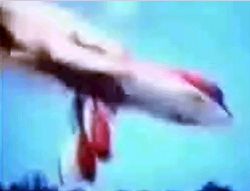 One witness said he and Wass "had researched the
C-130s and concluded that the A and B models had weak wing
structures," special agent Debra Mathews wrote.
One witness said he and Wass "had researched the
C-130s and concluded that the A and B models had weak wing
structures," special agent Debra Mathews wrote.
Another witness who knew Wass for more than 20 years said the
pilot had "raised pointed questions and concerns about the
aircraft, being old with wing problems."
Wass told him "the airplane was older than he or I, that the
military got rid of them for a reason," the witness told
Mathews.
The witness "stated that he did not want to see any more of his
friends go down."
Co-pilot Craig LaBare, 36, of Loomis and flight engineer Mike
Davis, 59, of Bakersfield also were killed in the June 17 crash
while dropping retardant in the Sierra about 70 miles south of
Reno. A Reno TV crew caught the moment on videotape when the
plane's wings broke off and the tanker crashed in a fiery
explosion.
"Pressure On These Men To Fly"
LaBare's widow, Laurie LaBare, said her husband had talked of
maintenance problems with the plane.
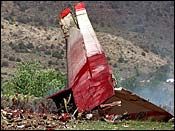 "It's absolutely ridiculous to put pressure on
these men to fly these planes ... these pieces of junk," she told
KATU-TV in Portland, Ore., last summer.
"It's absolutely ridiculous to put pressure on
these men to fly these planes ... these pieces of junk," she told
KATU-TV in Portland, Ore., last summer.
The Forest Service has stopped using C-130As for fighting fires.
The agency's crash investigation will be followed in coming months
by the National Transportation Safety Board's accident report.
The safety board has said fatigue cracks were found in the wings
and investigators are studying them and other safety issues to
determine what caused the wings to fail.
The Forest Service report said the plane had 21,947 hours of
flying time, mostly for the Air Force, and that a wing crack was
repaired in 1998. The report said earlier manufacturer tests on
similar planes found structural problems after 19,000 hours of
service.
The new report echoes findings of a Forest Service panel that
reviewed the nation's aerial firefighting fleet.
Culture Clash?
Like the panel's December report, the new document points to the
"culture" of federal firefighting forces and tries to answer a
nagging question: If the crew members feared for their safety, why
didn't they complain? Why did they continue to climb into aircraft
some labeled "flying deathtraps?"
There's no indication in the report that any of the crew members
lodged formal complaints with the Forest Service, federal
regulators or the tanker's owner, Hawkins & Powers Inc. of
Greybull, Wyo.
The panel called it "silent intimidation," being subtly expected
to ignore maintenance or training violations.
"They felt the absence of an employment 'safety net' and
asserted that they have no recourse or appeal process if they are
fired," the panel concluded.
Fear Of Flying. Fear Of Speaking Out.
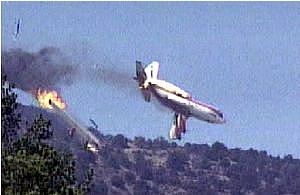 In the more recent investigation, Forest Service
special agents asked pilots if there were repercussions for
refusing to fly.
In the more recent investigation, Forest Service
special agents asked pilots if there were repercussions for
refusing to fly.
"They are subtle," said an air tanker pilot who dropped
retardant on the same Sierra fire just hours before the fatal
crash.
"You get a reputation. USFS (Forest Service) wants us to fly,
the operator wants us to fly, so we feel the pressure."
Another said, "If the crew complains, they get tagged as
'trouble tankers.'"
"They are deterred from speaking out," said the witness, who
gave an example about a Forest Service employee giving a flight
crew a hard time about maps it requested.
"When they complained they were told to 'check out' because they
were being transferred," the report said. The panel said an overall
"culture that emphasizes cost efficiency also has created an
admirable, but hazardous, "can-do" ethos that pervades firefighting
aviation.
"Unwittingly, the Forest Service has exploited the passion and
willingness of its firefighters to do more with less." The
so-called "silent intimidation" is among issues that members of the
Associated Airtanker Pilots want addressed during a meeting with
Forest Service aviation officials scheduled for Wednesday in
Sacramento. Rose Davis, a Forest Service spokeswoman for the
National Interagency Fire Center in Boise, Idaho, said the agency's
investigative report is intended to help determine if "there's
anything internally we could have done better."
But Davis said the Forest Service never pressures pilots to fly
unsafe equipment or in unsafe conditions. She said pilots are under
the authority of their employer, who fight the fires under contract
for the Forest Service.
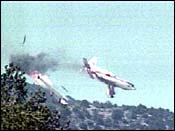 "As far as this accident goes, if they had issues
it was with their boss, the contractor. How they interact with
their employees is their own stuff," Davis said.
"As far as this accident goes, if they had issues
it was with their boss, the contractor. How they interact with
their employees is their own stuff," Davis said.
"Whatever Steve was thinking about his equipment or pressures in
his company was Steve's thing, not something the Forest Service was
involved in," she said.
Steve Wass' brother Jeff said the family doesn't blame either
the Forest Service or the contractor. "We don't feel there was any
intention of getting anybody hurt. Steve had flown with them for a
long time. He actually would be considered family to them," Jeff
Wass said.
"It's more of a concern of our family to make sure the Forest
Service pays the operators to maintain and provide a safe work
environment. Probably the biggest thing we can do for Steve is to
try to make sure that the industry becomes safer and that nobody
else loses family members in the same situation."
 ANN's Daily Aero-Linx (04.15.24)
ANN's Daily Aero-Linx (04.15.24) Classic Aero-TV: 'No Other Options' -- The Israeli Air Force's Danny Shapira
Classic Aero-TV: 'No Other Options' -- The Israeli Air Force's Danny Shapira Aero-News: Quote of the Day (04.15.24)
Aero-News: Quote of the Day (04.15.24) Airborne 04.16.24: RV Update, Affordable Flying Expo, Diamond Lil
Airborne 04.16.24: RV Update, Affordable Flying Expo, Diamond Lil ANN's Daily Aero-Term (04.16.24): Chart Supplement US
ANN's Daily Aero-Term (04.16.24): Chart Supplement US







